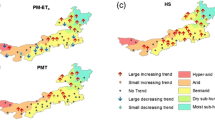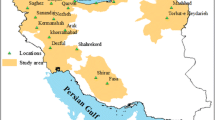Abstract
Sensitivity analysis of reference evapotranspiration (ETo) plays a key role in the simplification and improvement of measurements of terrestrial water balance. The aim of this study was to perform sensitivity analyses of the ASCE-Penman–Monteith reference ET equation (EToPM) for different tropical and subtropical climates, where a quantitative understanding of water fluxes to the atmosphere is limited. Sensitivity coefficients were derived on a daily basis for maximum and minimum air temperature, solar radiation, vapor pressure deficit and wind speed at 2 m height using data from 44-year of actual measurements for calibration (1970–2014), for nine different climatic zones across Brazil. A multiple regression analysis was performed to estimate the relation between meteorological data and EToPM across climatic zones. Seasonal and annual average estimates were obtained by averaging daily values and spatial patterns of EToPM were obtained by interpolating meteorological data from all sampled locations. Five climate variables were used in the analysis, which revealed diverse effects on EToPM across seasons and climatic zones. In order of importance, EToPM was most sensitive to annual variation in vapor pressure deficit (VPD), wind speed (U2) and solar radiation (Rs) in all climate types. Our analysis also showed that VPD, calculated from measurements of relative humidity and temperature (T), are essential to accurately predict EToPM across tropical and subtropical climates. Due to the lack of direct meteorological measurements in many Brazilian regions, we recommend the adjustment of climate-driven hydrological fluxes predictions to the most sensitive variables, i.e., VPD, to improve the precision of reference ET losses. Our results will be useful in delineating the influence of different climatic variables in the ASCE Penman–Monteith model and in guiding new climatic modeling efforts in tropical and subtropical regions.




Similar content being viewed by others
References
Allen RG (2008) Quality assessment of weather data and micrometeological flux impacts on evapotranspiration calculations. J Agric Meteorol 64:191–204
Allen RG, Pereira LS, Raes D, Smith M (1998) Crop evapotranspiration: guidelines for computing crop water requirements, 1st edn. Food and Agriculture Organization of the United Nations, Rome
Allen RG, Walter IA, Elliott R, Mecham B, Jensen ME, Itenfisu D, Howell TA, Snyder R, Brown P, Echings S, Spofford T, Hattendorf M, Cuenca RH, Wright L, Martin D. Issues (2000) Requirements and challenges in selecting and specifying a standardized et equation. pp 201–208. In: Evans RG, Benham BL, Trooien TP (eds) Proceedings of the National Irrigation Symposium, 14–16 Nov 2000, Phoenix, AZ, American Society of Agricultural and Biological Engineers, St. Joseph, MI
Allen RG, Walter IA, Elliott RL, Howell TA, Itenfisu D, Jensen ME, Snyder RL (2005) The ASCE standardized reference evapotranspiration equation. American Society of Civil Engineers, Reston
Álvares CA, Stape JL, Sentelhas PJ, Gonçalves JLM, Sparovek G (2013) Koppen’s climate classification map for Brazil. Meteorol Z 22:711–728
Berengena J, Gavilan P. Reference (2005) ET estimation in a highly advective semiarid environment. J Irrig Drain Eng ASCE 131:147–163
Blaney HF, Criddle WD (1950) Determining water requirements in irrigated area from climatological irrigation data. US Department of Agriculture: Soil Conservation Service, Somerset
Butt N, New M, Lizcano G, Malhi Y (2009) Spatial patterns and recent trends in cloud fraction and cloud-related diffuse radiation in Amazonia. J Geophys Res 114:D21104
Carvalho LGC, Rios GFA, Miranda WL, Castro Neto P (2011) Reference evapotranspiration: current analysis of different estimating methods. Pesquisa Agropecuária Tropical 41:456–465
Carvalho LG, Evangelista AWP, Oliveira KMG, Silva BM, Alves MC, Sá Júnior A, Miranda WL (2013) FAO Penman–Monteith equation for reference evapotranspiration from missing data. Idesia 31:39–47
Chen B, Chen JM, Ju W (2007) Remote sensing-based ecosystem–atmosphere simulation scheme (EASS)-model formulation and test with multiple-year data. Ecol Model 209:277–300
Clark DAS, Piper C, Keeling CD, Clark DB (2003) Tropical rain forest tree growth and atmospheric carbon dynamics linked to inter-annual temperature variation during 1984–2000. Proc Natl Acad Sci 100:5852–5857
EMBRAPA—Brazilian Agricultural Research Corporation (2015) Embrapa Satellite Monitoring. https://www.embrapa.br/en/monitoramento-por-satelite. Accessed 28 July 2016
ESRI ArcGIS Desktop Release 10 (2011) Environmental Systems Research. https://www.esri.com/enus/arcgis/about-arcgis/overview. Accessed 25 July 2016
Estévez J, Gavilán P, Berengena J (2009) Sensitivity analysis of a Penman–Monteith type equation to estimate reference evapotranspiration in southern Spain. Hydrology Processes 23:3342–3353
Fearnside PM (2004) Are climate change impacts already affecting tropical forest biomass? Glob Environ Change 14:299–302
Fisch G, Marengo JM, Nobre CA (1998) The climate of Amazonia: a review. Acta Amazonica 28:101–126
Gatti LV, Gloor M, Miller JB, Doughty CE, Malhi Y, Domingues LG, Basso LS, Martinewski A, Correia CSC, Borges VF, Freitas S, Braz R, Anderson LO, Rocha H, Grace J, Phillips OL, Lloyd J (2014) Drought sensitivity of Amazonian carbon balance revealed by atmospheric measurements. Nature 506:76–80
Gong L, Xu C, Chen D, Halldin S, Chen YD (2006) Sensitivity of the Penman–Monteith reference evapotranspiration to key climatic variables in the Changjiang (Yangtze River) basin. J Hydrol 329:620–629
Goyal RK (2004) Sensitivity of evapotranspiration to global warming: a case study of arid zone of Rajhastan (India). Agric Water Manag 69:1–11
Haghighi E, Kirchner JW (2017) Near-surface turbulence as a missing link in modeling evapotranspiration-soil moisture relationships. Water Resour Res 53:5320–5344
Hijmans RJ, Cameron SE, Parra JL, Jones PG, Jarvis A (2005) Very high resolution interpolated climate surfaces for global land areas. Int J Climatol 25:1965–1978
Hupet F, Vanclooster M (2001) Effect of the sampling frequency of meteorological variables on the estimation of reference evapotranspiration. J Hidrol 243:192–204
INMET—Brazilian National Institute of Meteorology (2014) Meteorological Database for Education and Research (BDMEP). http://www.inmet.gov.br/portal/index.php?r=bdmep/bdmep. Accessed 15 June 2014
Irmak S, Irmak A, Allen RG, Jones JW (2003) Solar and net radiation-based equations to estimate reference evapotranspiration in humid climates. J Irrig Drain Eng ASCE 129:336–347
Irmak S, Payero JO, Martin DL, Irmak A, Howell TA (2006) Sensitivity analyses and sensitivity coefficients of standardized daily ASCE-Penman–Monteith equation. J Irrig Drain Eng 132:564–578
Itenfisu D, Elliott RL, Allen RG, Walter IA (2003) Comparison of reference evapotranspiration calculations as part of ASCE standardization effort. J Irrig Drain Eng 129:440–448
Jasechko S, Sharp ZD, Gibson JJ, Birks SJ, Yi Y, Fawcett PJ (2013) Terrestrial water fluxes dominated by transpiration. Nature 496:347–350
Jerszurki D, Couvreur V, Maxwell T, Silva LCR, Matsumoto N, Shackel K, Souza JLM, Hopmans J (2017) Impact of root growth and hydraulic conductance on canopy carbon-water relations of young walnut trees (Juglans regia L.) under drought. Sci Hortic 226:342–352
Lemos Filho LCA, Mello CR, Faria MA, Carvalho LG (2010) Spatial-temporal analysis of water requirements of coffee crop in Minas Gerais State, Brazil. Revista Brasileira de Engenharia Agrícola e Ambiental 14:165–172
Liqiao L, Lijuan L, Li Z, Jiuyi L, Dejuan J, Mingxing X, Wenxian S (2008) Sensitivity of the reference crop evapotranspiration in growing season in the West Songnen Plain. Trans Chin Soc Agric Eng 18:340–347
MAPA—Brazilian Ministry of Agriculture, Livestock and Food Supply (2016) Food exportation. http://www.agricultura.gov.br/vegetal/exportacao. Accessed 29 Dec 2016
Maxwell T, Silva LCR, Horwath W (2014) Using multi-element isotopic analysis to decipher drought impacts and adaptive management in ancient agricultural systems. Proc Natl Acad Sci 45:4807–4808
Maxwell T, Silva LCR, Horwath WR (2018) Integrating effects of species composition and soil properties to predict shifts in montane forest carbon–water relations. Proc Natl Acad Sci 115:4219–4226
Monteith JL (1965) Evaporation and environment. In: 19th symposia of the Society for Experimental Biology. University Press, Cambridge, pp 205–234
Monteith JL. Evaporation and environment (1964) In the state and movement of water in living organisms. Symp Soc Exp Biol 19:205–234
Monteith JL, Unsworth MH (1990) Principles of environmental physics, 2nd edn. Edward Arnold, New York
Murray FW (1967) On the computation of saturation vapor pressure. J Appl Meteorol 6:203–204
Nobel PS (1991) Physicochemical and environmental plant phisiology, 1st edn. Academic Press, San Diego
Pereira AR, Sentelhas PC, Folegatti MV, Villa Nova NA, Maggiotto SR, Pereira FAC (2002) Substantiation of the daily FAO-56 reference evapotranspiration with data from automatic and conventional weather stations. Revista Brasileira de Agrometeorologia 10:251–257
Pereira LS, Allen LG, Smith M, Raes D (2015) Crop evapotranspiration estimation with FAO56: past and future. Agric Water Manag 147:4–20
Rana G, Katerji N (1998) A measurement based sensitivity analysis of the Penman–Monteith actual evapotranspiration model for crops of different height and in contrasting water status. Theor Appl Climatol 60:141–149
Saxton KE (1975) Sensitivity analysis of the combination evapotranspiration equation. Agric Meteorol 15:343–353
Schymanski SJ, Or D (2016) Wind increases leaf water use efficiency. Plant Cell Environ 39:1448–1459
Shaw EM (1993) Hydrology in practice, 3rd edn. Chapman and Hall, London
Silva LCR (2015) From air to land: understanding water resources through plant-based multidisciplinary research. Trends Plant Sci 20:399–401
Silva LCR, Anand M (2013) Historical links and new frontiers in the study of forest–atmosphere interactions. Community Ecol 14:208–218
Silva AO, Moura GBA, Silva EFF, Lopes PMO, Silva APN (2011) Spatio-temporal analysis of reference evapotranspiration under different regimes of precipitation in Pernambuco. Revista Caatinga 24:135–142
Silva LCR, Pedroso G, Doane TA, Mukome FND, Horwath WD (2015) Beyond the cellulose: oxygen isotope composition of plant lipids as a proxy for terrestrial water balance. Geochem Perspect Lett 1:33–42
Smajstrla AG, Zazueta FS, Schmidt GM (1987) Sensitivity of potential evapotranspiration to four climatic variables in Florida. Soil Crop Sci Soc Fla 46:21–26
Souza JLM, Fezer KF, Gurski BC, Jerszurki D, Pachechenik PE (2016) Soil water balance in different densitites of Pinus taeda in Southern Brazil. Acta Sci 38:265–271
Sulman BN, Roman DT, Yi K, Wang L, Phillips RP, Novick KA (2016) High atmospheric demand for water can limit forest carbon uptake and transpiration as severely as dry soil. Geophys Res Lett 43:9686–9695
Walter IA, Allen RG, Elliott R, Jensen ME, Itenfisu D, Mecham B et al (2000) ASCE’s standardized reference evapotranspiration equation. In: National irrigation symposium, 4. 2000 Phoenix. Proceedings, vol 1. American Society of Agricultural Engineers, Phoenix, pp 209–215
Wang K, Dickinson RE (2012) A review of global terrestrial evapotranspiration: observation, modeling, climatology and climatic variability. Rev Geophys 50:1–54
Wright JL, Jensen ME (1972) Peak water requirements of crops in southern Idaho. J Irrig Drain Eng 98:193–201
Xu CY, Singh VP (2005) Evaluation of three complementary relationship evapotranspiration models by water balance approach to estimate actual regional evapotranspiration in different climatic regions. J Hidrol 308:105–121
Yan H, Wang SQ, Billesbach D, Oechel W, Zhang JH, Meyers T et al (2012) Global estimation of evapotranspiration using a leaf area index-based surface energy and water balance model. Remote Sens Environ 124:581–595
Acknowledgements
Coordination for the Improvement of Higher Education Personnel (CAPES/PDSE, Brazil).
Author information
Authors and Affiliations
Corresponding author
Additional information
Publisher’s Note
Springer Nature remains neutral with regard to jurisdictional claims in published maps and institutional affiliations.
Rights and permissions
About this article
Cite this article
Jerszurki, D., de Souza, J.L.M. & Silva, L.d.C.R. Sensitivity of ASCE-Penman–Monteith reference evapotranspiration under different climate types in Brazil. Clim Dyn 53, 943–956 (2019). https://doi.org/10.1007/s00382-019-04619-1
Received:
Accepted:
Published:
Issue Date:
DOI: https://doi.org/10.1007/s00382-019-04619-1




